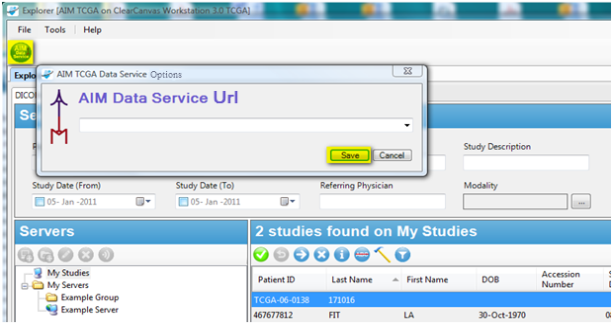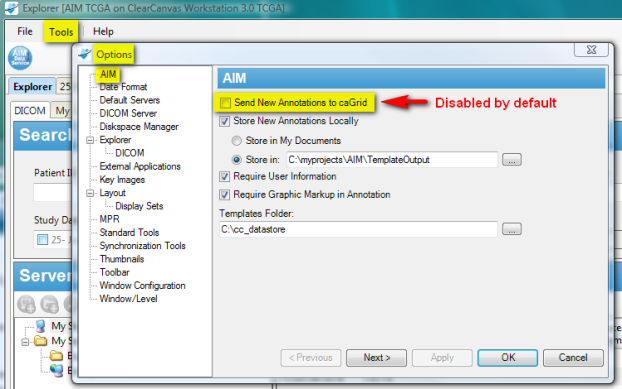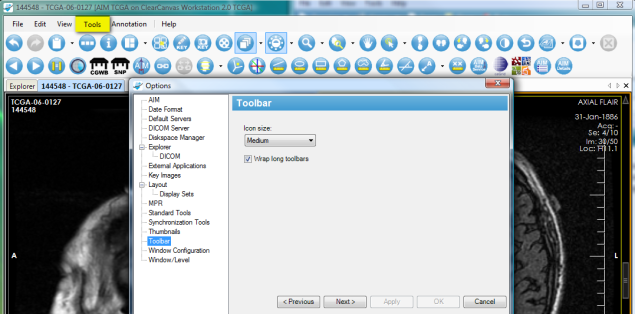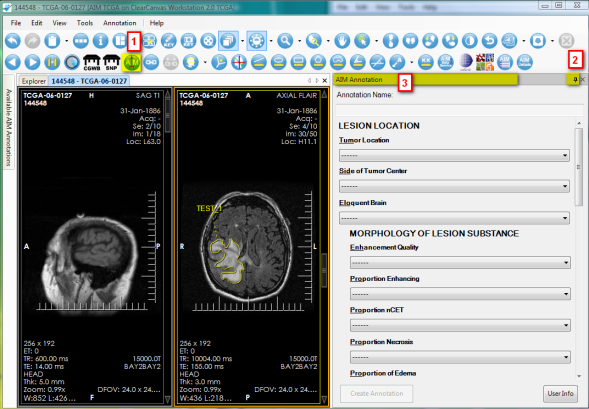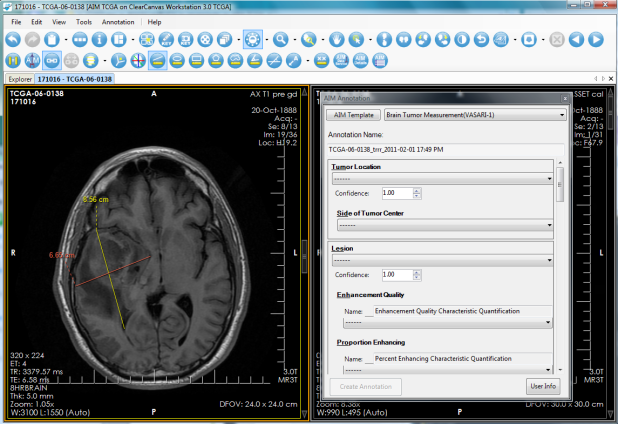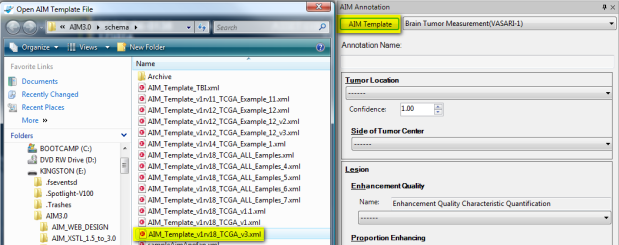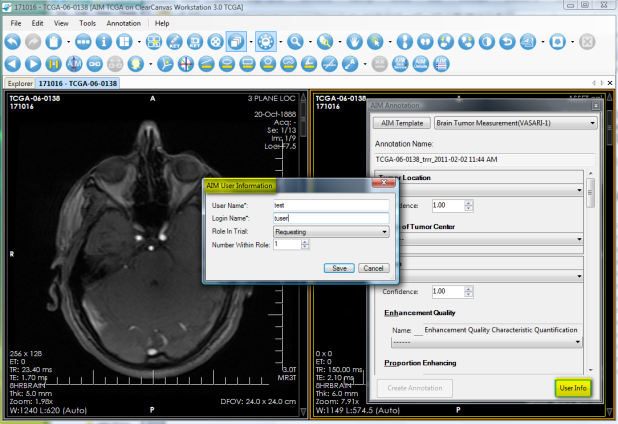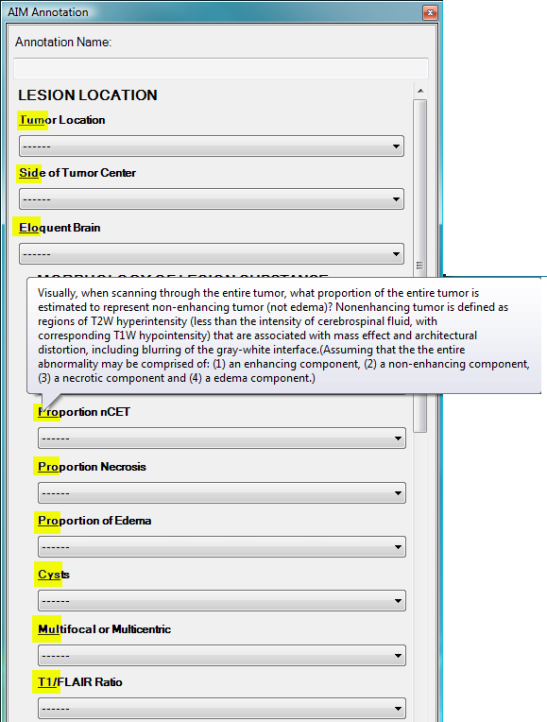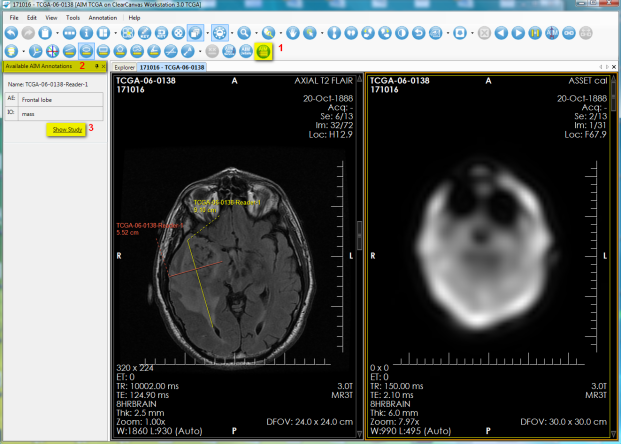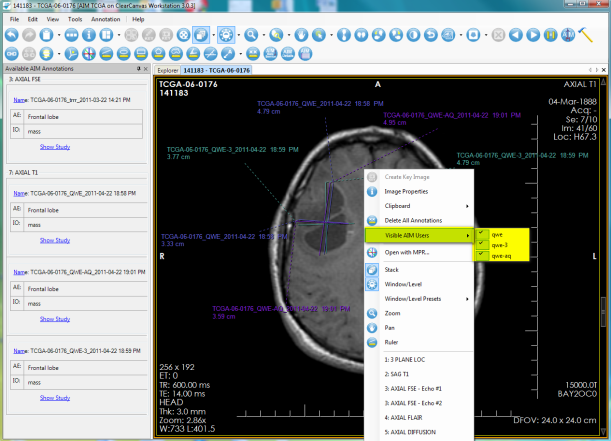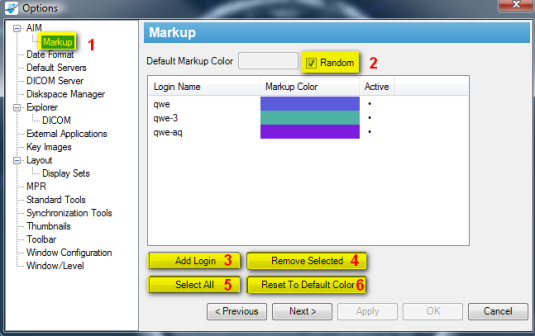 |
Page History
...
Click to configure the AIM Data Service. You can access the data service configuration from the explorer toolbar, shown in (Fig Figure 1), or through an opened study's toolbar, shown in (Fig Figure 2).
Figure 1. Access AIM Data Service Options from Explorer Toolbar
...
To access the AIM settings, on the ClearCanvas menu, select Tools > Options > AIM. When finished, click Apply to commit the changes. This is demonstrated in (Fig Figure 3).
Figure 3. AIM Options
| Info | ||
|---|---|---|
| ||
By default, the setting for sending AIM XML documents to the AIM 3.0 Data Service is disabled. You must enable this option in order to have new AIM XML documents sent to the AIM Data Service. If you have neither set the AIM Data Service destination nor enabled the Send New Annotations to caGrid option, your existing AIM XML documents will not be sent to the AIM 3.0 Data Service. |
...
The ClearCanvas workstation allows a user to change the size of icons and show all icons on one screen. To do so, select Tools > Options > Toolbar . The recommended icon size is medium and you should select the Wrap long toolbars option. See (Fig Figure 4).
Figure 4. Setting Toolbar Option
...
To activate the AIM template tool in (Fig Figure 5), click the AIM template tool button (#1). If you put the pin down (#2), you can detach the AIM Template tab by putting the mouse pointer at the header (#3) and dragging it out (Fig , as illustrated in Figure 5-1).
Figure 5. Activate AIM Template
Figure 5-1. Detached AIM Template Tool
| Info | ||
|---|---|---|
| ||
When an AIM annotation is created, the following conditions are applied (based on AIM default settings in Section II "Setting #Setting AIM Options");
|
...
An AIM template XML document can be imported by clicking the AIM Template button, as shown n (Fig in Figure 6). Windows Explorer opens a predefined folder described in the Setting AIM Options section.
Figure 6. Importing an AIM Template
...
Author information as depicted in (Fig Figure 7) which can be changed. To use this feature, click the User Info button to activate the AIM User Information form. Enter appropriate information and click Save.
...
If you are sharing the workstation with another reader, you must change or at least verify that the information in the "User Info" section reflects your personal credentials._*
Figure 7. AIM User Information
...
A detailed description of a question can be seen by placing the mouse pointer over the first three characters of each feature name, as shown in (Fig Figure 8).
Figure 8. Detail Description of a Question
...
The AIM locator, depicted in (Fig 9), allows users to see existing AIM instances available in a study. A list of available AIM instances is displayed below the Available AIM Annotations section, which is #2 in the following image. To access this feature and see an AIM annotation, click Show Study, which is #3 in the following image.
Figure 9. AIM Locator
AIM Annotation Details
The AIM annotation details (Fig 10) , as illustrated by Figure 10, allow a user to examine detailed information captured in an AIM instance. To access this feature, you select an image containing an AIM instance and then click the AIM Details button, as shown in (#1). The AIM Annotation Details panel appears. This panel contains information tabs including Anatomic Entity, Imaging Observation, Calculations, and All Details. The All Details tab (shown in #3) allows a user to see information related to both Anatomic Entity and Imaging Observation and their characteristics.
...
For a given image in an imaging study that has more than one reader interpreting and creating AIM annotations, the workstation can display every annotation while allowing you to turn off markups from a selected group of readers. (Fig Figure 11 ) depicts an image with three markups from three readers. The markup from reader named qwe-3 was turned off.
A right-mouse click on the image activates a pop-up menu with a "Visible AIM Users" option to turn readers' markups on or off.
Figure 11. AIM Markup Display
By default, the workstation also displays annotations created by different users in different colors. Selecting Tools > Options > AIM > Markup allows you to change which colors are used for which user's AIM annotations (Fig Figure 12). Selected by default, the "Random" checkbox (#2) assigns a random color to each user. If you do not select the option, you can override the random color with a different color. You can also override the color used to depict one or more user's AIM annotionsannotations. The default color may be changed by clicking the button to the left of the checkbox when the checkbox is deselected. A user's color may be changed by clicking the color next to their name and selecting a new color in the color picker dialog that appears. Users not yet loaded into the list may be added to the list by clicking the "Add Login" button (#3). Selected users may be removed from the list (resetting their colors to the default) by selecting the "Remove Selected" button (#4). All users in the list may be selected by clicking the "Select All" button (#5). Selected users may have their color reset to the default color, either random or predefined as determined by the Random checkbox (#2), by clicking the "Reset To Default Color" button (#6).
Figure 12. AIM Markup Display
...
Users can enter search parameters (Fig 14) based on a single value or mutiple multiple values of Patient ID, Patient's Name, Sex, Birth Date, Project name at NCI, Slice Thickness, Study Instance UID, and Modality.
...
You can enter search parameters (Fig 17) based on a single value or mutiple multiple values of Anatomic Entities, Anatomic Entity Characteristics, the User who created the AIM XML documents, Imaging Observation, Imaging Observation Characteristics, and Study Instance UID.
...
Columns in the AIM Data Service page can be selected or deselected to display or hide an available result. Fig Figure 18 depicts that all available columns for the service have been selected.
...
